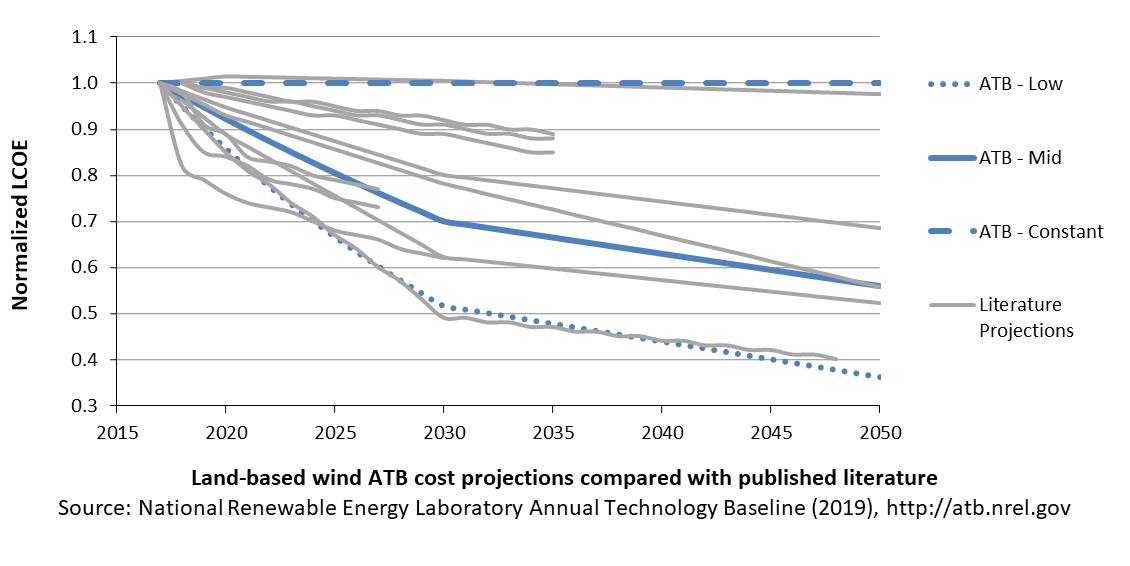Land-Based Wind
Plant Cost and Performance Projections Methodology
ATB projections were derived from two different sources for the Mid and Low cases:
- Mid Technology Cost Scenario: 2030 cost estimates for the Mid scenario are estimated (1) using CSM and inputs from analyst-predicted turbine technology in 2030 that are specific to the Mid case (Stehly et al., 2020) and (2) applying technology-specific cost adjustments; beyond 2030, the costs are derived from estimated change in LCOE from 2030 to 2050 based on historical land-based wind LCOE and single-factor learning rates ranging from 10.5% to 18.6%, meaning LCOE declines by this amount for each doubling of global cumulative wind capacity (Wiser et al., 2016). Future FOM is assumed to decline by approximately 25% by 2050 in the Mid case. These values are informed by recent work benchmarking work for wind power operating costs in the United States (Wiser et al., 2019). The projected capacity factors in 2030 are calculated in SAM using the inputs of the predicted turbine technology in 2030 that are specific to the Mid case (Stehly et al., 2020) for each of the TRGs; additional wind plant performance and availability are also applied through technology innovations assessed in the SMART wind power plant of the future work (Dykes et al., 2017); beyond 2030, analysts predict generally modest improvements in wind plant performance through 2050 for the resource-rich site (i.e., TRGs 1 and 2) and increasing slightly for the less favorable resource sites (i.e., TRGs 8-10).
- Low Technology Cost Scenario: 2030 cost estimates for the Low scenario are estimated (1) using NREL's CSM and inputs from the analyst-predicted turbine technology in 2030 that are specific to the Low case (Stehly et al., 2020) and (2) applying technology-specific cost adjustments; beyond 2030, the costs are derived using the same learning rate methodology as for the Mid case but assuming an increase in global cumulative capacity. Future FOM is assumed to decline by approximately 45% in the Low case. These values are informed by recent work benchmarking work for wind power operating costs in the United States (Wiser et al., forthcoming). The projected capacity factors in 2030 are calculated in SAM using the inputs of the predicted turbine technology in 2030 that are specific to the Low case (Stehly et al., 2020) for each of the TRGs; additional wind plant performance and availability are also applied through technology innovations assessed in the SMART wind power plant of the future work (Dykes et al., 2017), but they assume further reduction in losses than in the Mid case; beyond 2030, analysts predict slightly higher improvements in wind plant performance than in the Mid case through 2050 for the resource-rich site (i.e., TRGs 1 and 2) and increasing slightly for the less favorable resource sites (i.e., TRGs 8-10).
Projections of the cost of wind energy from the literature provide context for the ATB Constant, Mid, and Low technology cost projections. The ATB Mid cost projection results in LCOE reductions that are higher than other scenarios that are in median range of the literature ((Shreve, 2018), (BNEF, 2018)), and lower than ((Kost, Shammugam, Julch, Huyen-Tran, & Schlegl, 2018), (Wiser et al., 2016)). The ATB Low cost projection, which corresponds to the NREL bottom-up cost analysis, is relatively in line with the leading experts prediction (Wiser et al., 2016).
- Mid case projection institutions: Bloomberg New Energy Finance, Wood Mackenzie, Global Wind Energy Council.

References
The following references are specific to this page; for all references in this ATB, see References.BNEF. (2018b). BloombergNEF - EPVAL Wind Inputs 2H 2018 - US - Onshore. BNEF.
Dykes, K., Hand, M., Stehly, T., Veers, P., Robinson, M., Lantz, E., & Tusing, R. (2017). Enabling the SMART Wind Power Plant of the Future Through Science-Based Innovation (No. NREL/TP-5000-68123). https://doi.org/10.2172/1378902
Kost, C., Shammugam, S., Julch, V., Huyen-Tran, N., & Schlegl, T. (2018). Levelized Cost of Electricity Renewable Energy Technologies. Retrieved from Fraunhofer website: https://www.ise.fraunhofer.de/content/dam/ise/en/documents/publications/studies/EN2018_Fraunhofer-ISE_LCOE_Renewable_Energy_Technologies.pdf
Shreve, D. (2018). United States Wind Energy Market Outlook. Wood Mackenzie.
Stehly, T., Beiter, P., Heimiller, D., & Scott, G. (2020). 2018 Cost of Wind Energy Review (Technical Report No. NREL/TP-5000-74598). Retrieved from National Renewable Energy Laboratory website: https://www.nrel.gov/docs/fy20osti/74598.pdf
Wiser, R., Bolinger, M., & Lantz, E. (2019). Assessing Wind Power Operating Costs in the United States: Results from a Survey of Wind Industry Experts. Renewable Energy Focus.
Wiser, R., Jenni, K., Seel, J., Baker, E., Hand, M., Lantz, E., & Smith, A. (2016). Forecasting Wind Energy Costs and Cost Drivers: The Views of the World's Leading Experts (No. LBNL-1005717; p. 87 pp.). Retrieved from Lawrence Berkeley National Laboratory website: https://emp.lbl.gov/publications/forecasting-wind-energy-costs-and
